Why Does risk reduction now sit on the CFO’s desk?
Regulators, auditors and rating agencies increasingly probe penalty clauses, evergreen renewals, change-of-control fees, data-breach indemnities.
These contractual obligations sit off the balance sheet until a trigger event occurs, at which point they can destabilise cash-flow forecasts, breach covenant ratios or torpedo deal valuations.
Because the finance function signs off guidance to markets and boards, any blind spot in the contract portfolio ultimately converts into earnings-volatility risk for the CFO to explain.
How does improving contract visibility lead to Value-Creating Opportunities?
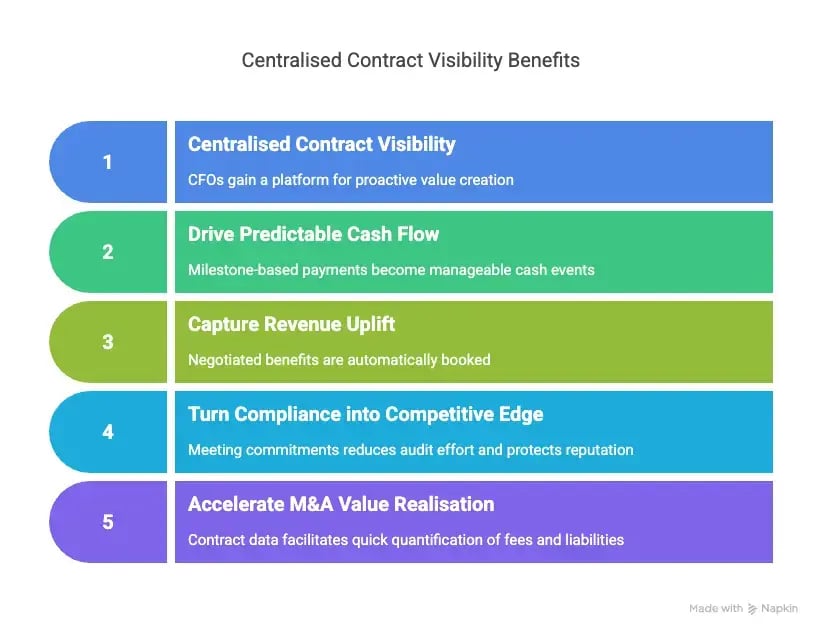
Centralised contract visibility gives CFOs a platform for proactive value creation. When every clause and commitment is searchable and connected to real-time dashboards, businesses can:
- Drive Predictable Cash Flow & Confident Forecasting: Milestone-based payments, variable pricing and minimum-spend commitments move from “unknown unknowns” to scheduled cash events you can manage. Forecasting becomes more accurate, liquidity planning strengthens and idle capital can be redeployed where it earns a return.
- Capture Revenue Uplift & Eliminate Waste: Rebates, volume discounts and tiered-pricing triggers are surfaced automatically, ensuring negotiated benefits are actually booked. At the same time, visibility flags unused licences or services, letting you cut spend before it hits the profit and loss sheet.
- Turn Compliance into a Competitive Edge: Clause-level insight highlights service-level obligations, data-protection terms and other regulatory requirements in time to act. Meeting these commitments consistently reduces audit effort, protects reputation and can even lower the cost of capital with lenders and insurers that reward strong governance.
- Accelerate & De-risk M&A Value Realisation: With contract data at your fingertips, diligence teams quickly quantify change-of-control fees, termination rights and embedded liabilities. Integration plans start on day one, synergy cases stand up to scrutiny and deal value is protected.
By reframing visibility as a springboard for growth, efficiency and strategic agility, CFOs can lead the charge to transform contracts into instruments of financial advantage.
what is The CFO's Evolving Role in Contract Risk Reduction?
The CFO's role in contract governance needs to extend beyond mere oversight, to include active leveraging of contract data to create financial value and strategic advantage. Areas involved include:
- Optimising Working Capital: By gaining clear insight into payment terms and obligations, CFOs can strategically manage cash flow, reduce idle capital, and enhance working capital efficiency.
- Strategic Vendor Portfolio Management: Maximised visibility into all vendor contracts allows CFOs to identify opportunities for consolidating vendors, negotiating better terms, and leveraging competition to drive down costs. These will ultimately enhance return on investment from vendor relationships.
- Supporting Agile Growth Initiatives: Ready access to accurate contract data enables CFOs to make swift, informed decisions regarding new market entries, product development or strategic partnerships, underpinning the organisation's strategic agility.
By embracing this expanded role, CFOs can transform contract management from a reactive necessity into a proactive driver of financial performance and strategic advantage. This ensures the finance function is at the heart of value creation, not just risk mitigation.
How can you Build a visibility-first culture for contract management?
Achieving contract visibility requires much more than a technology upgrade; it necessitates a cultural shift within the organisation. CFOs are uniquely positioned to lead this transformation by:
- Auditing the Current State: Map existing contract storage, ownership, and review processes to identify gaps and high-risk areas.
- Establishing Governance Standards: Define clear policies for contract creation, approval, storage and renewal, standardising metadata for consistent reporting.
- Aligning Stakeholders: Bring together key departments like Legal, Procurement, Finance and Compliance to agree on shared goals and workflows, supported by a VCLM tool like Gatekeeper that offers role-based access and collaboration.
- Training Teams on Visibility Tools: Ensure all relevant users are proficient in accessing, updating and analysing contract data within the VCLM platform, highlighting how visibility benefits their specific objectives.
- Tracking and Celebrating Success: Monitor key performance indicators such as time-to-renewal awareness, missed obligation rates, and audit readiness. Publicise wins to reinforce VCLM adoption and drive behavioural change.
Creating a visibility-first culture requires consistent effort and commitment from leadership, but the long-term benefits in terms of reduced risk, improved efficiency and enhanced strategic decision-making are substantial.
The CFO is critical for championing this cultural shift and embedding contract visibility into the organisation's standardised approach to the financial risks inherent in its contracts.
How does Gatekeeper Improve Contract Visibility?
Gatekeeper transforms contracts from static documents into dynamic tools for financial control, risk mitigation, and strategic planning.
Data-Driven Strategic Decision Making
Providing CFOs with comprehensive, real-time insights to make informed decisions on vendor consolidation, cost-cutting or renegotiation opportunities, transforms them into proactive financial leaders.Gatekeeper’s Spend Module allow CFOs to monitor contract value, upcoming obligations, current risk status and compliance metrics in real-time. A wide range of configurable standard reports are available to display various aspects of recorded information.
 Enhanced Financial Forecasting and Budget Accuracy
Enhanced Financial Forecasting and Budget Accuracy
The availability of real-time, actionable intelligence needed for precise budgeting and cash flow forecasting eliminates financial surprises and enables more reliable financial planning and allocation of budgets.With Gatekeeper, CFOs and other authorised users can access all contracts in a single centralised platform, with key data fields extracted and standardised for easy analysis. Integration with ERP, procurement and financial planning tools such as Netsuite syncs contract data with budgeting, forecasting and audit systems.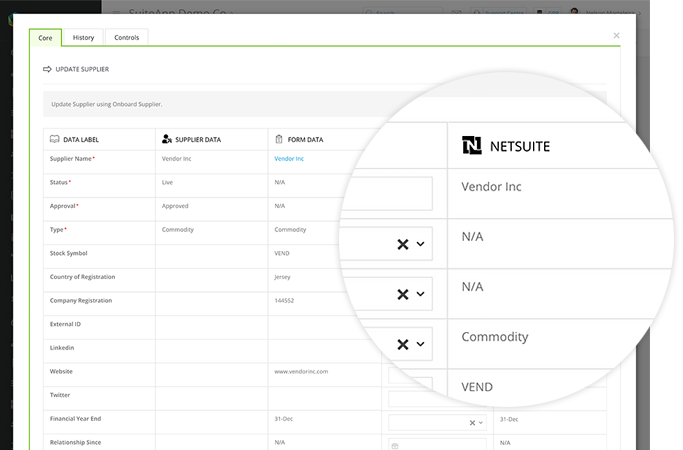
Fortified Compliance and Reduced Financial Risk
Integrated directly within the Gatekeeper platform, MarketIQ Finance equips finance leaders with the real-time visibility and contract intelligence needed to pre-empt compliance breaches and mitigate financial risk.
By continuously monitoring supplier health and surfacing key risk indicators, MarketIQ Finance acts as an early warning system, preventing disruptions before they impact the bottom line.
This empowers CFOs to work with teams to identify clauses that expose the business to liability, flag suppliers showing signs of distress, and access a single source of truth for audit readiness.
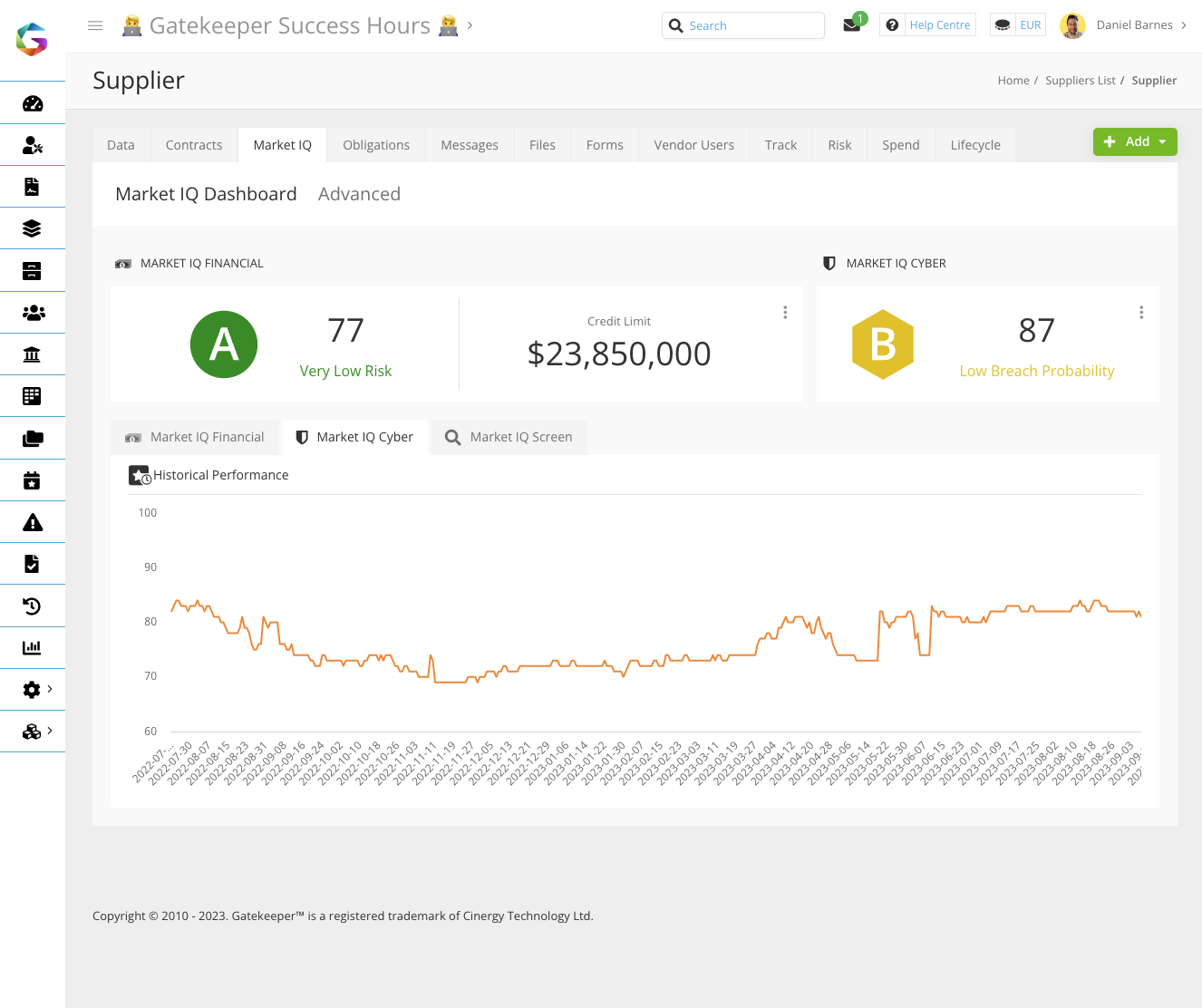
Maximised Contract Value and Cost Savings
Ensuring that no opportunity to renegotiate favourable terms or eliminate unnecessary spend is overlooked has a direct impact on the bottom line.
Proactive vendor and contract management is essential for driving stronger ROI from every vendor relationship, especially in an environment where cost control and margin protection are top priorities for CFOs.
Gatekeeper’s best practice automated workflows are triggered well ahead of renewal deadlines, notice periods, or key contract milestones. This gives CFOs and their teams ample time to assess vendor performance, align stakeholders, and make informed decisions.
With Gatekeeper, finance leaders gain a clear, real-time view of contractual commitments and savings potential across the vendor portfolio.
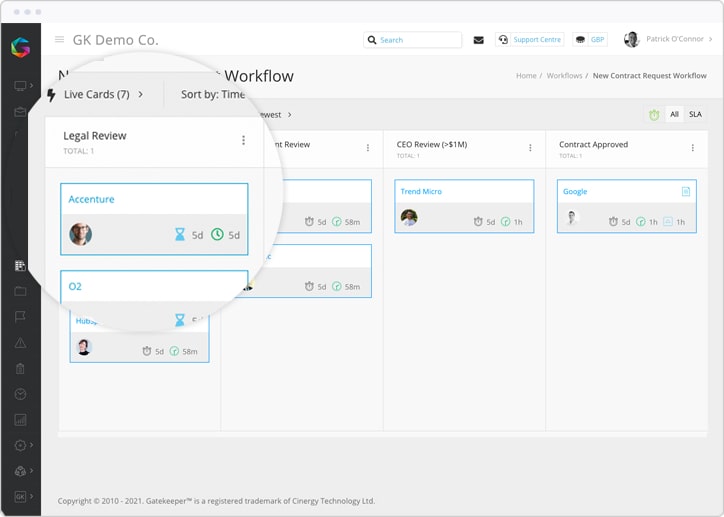
Strategic Vendor Consolidation for Cost Control and Risk Reduction
For CFOs seeking to optimise spend and improve financial resilience, vendor consolidation represents a powerful lever.
Gatekeeper enables finance leaders to rationalise their supplier base by identifying redundancies, standardising terms, and consolidating contracts, unlocking immediate cost savings and reducing exposure to third-party risk.
By consolidating vendors, CFOs gain tighter control over indirect spend, simplify compliance, and free up resources for higher-value strategic initiatives.
Conclusion
By taking ownership of contract governance and strategically investing in VCLM software like Gatekeeper, finance leaders can eliminate costly hidden risks, mitigate exposure, and empower smarter, faster decision-making across the entire contract lifecycle.
This proactive approach positions CFOs and their organisations to cope with volatility, uncertainty, complexity and ambiguity with confidence, and unlock the full value of their vendor and contract relationships.
CFOs who take ownership of this agenda won’t just reduce risk, they’ll increase the organisation’s financial resilience and its readiness for what comes next.
Ready to transform your vendor and contract management and empower your finance team? Book your demo today.
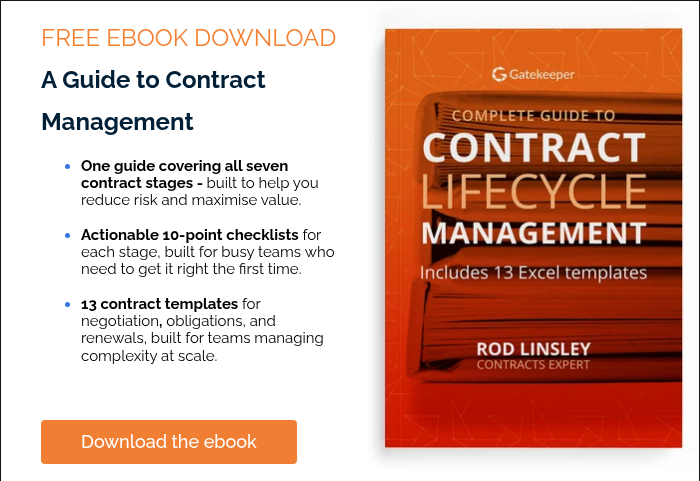

.png)
.png)
.png)
-4.png)